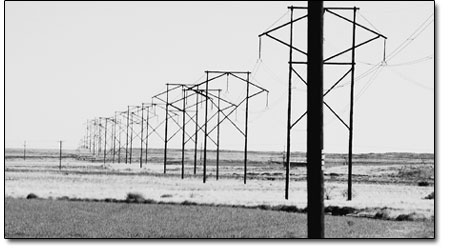|
| ||
| Changing the course of coal SideStory: High in the ozone: San Juan County officially hits nonattainment
by Will Sands The future of coal-fired power is looking murkier by the moment. Clean air advocates won several recent victories in Washington, D.C. – victories that promise to reverberate through the Four Corners. Yet in spite of the likelihood of more and tighter regulations, the proposed Desert Rock Power Plant is forging ahead. Based on a petition and a U.S. Supreme Court mandate, the Environmental Protection Agency recently started changing course on coal-fired power. In late February, the agency’s new administrator, Lisa Jackson, offered to reconsider whether carbon dioxide, the leading greenhouse gas, should be regulated under the Clean Air Act. Then last week, the U.S. Supreme Court ruled that the EPA has been negligent by failing to reduce mercury emissions from power plants. The news was significant for the Four Corners, which is already home to three coal-fired powers plants – two of which have been named among the nation’s dirtiest – and the location of choice for the massive Desert Rock Power Plant. With New Mexico’s San Juan County earning recent marks for ozone pollution (see sidebar) and high mercury levels tainting Four Corners rivers and lakes, the news from Washington has significant local ramifications. Mike Eisenfeld, New Mexico coordinator for San Juan Citizens Alliance, noted that major changes could be coming for the local airshed. “Really what this is pointing toward is that new coal-fired power plants are going to have to evaluate technology for reducing greenhouse gas emissions,” he said. “What that means for the Four Corners is that Desert Rock will be going back to the drawing board.” The EPA is still many steps away from regulating carbon emissions, however. Jackson’s late February announcement essentially overruled a Bush administration memo that declared the EPA would not and had no responsibility to regulate carbon emissions. While the decision could mark the first step toward limits on greenhouse gases, a great deal of study and evaluation remains. “EPA’s fundamental mission is to protect human health and the environment, and we intend to do just that,” Jackson said.Sithe Global, the company partnering with the Navajo Nation to build Desert Rock southwest of Farmington, takes a different view of the announcement. Like he has before, Jeff Holmstead, an attorney for Desert Rock and former EPA Air Administrator, countered that the announcement was expected. “It’s a clever procedural move that allows the new administration to distance itself from the Bush administration without actually changing anything about how carbon dioxide is regulated,” he said. Whether the greenhouse gas is regulated or not will depend on a lengthy public process, and Desert Rock backers are optimistic about the outcome of such a process. “Coming up with a new framework to regulate carbon dioxide will be a huge challenge, unless the new administration wants to force every significant construction project in the U.S. to stop work until they go through a years-long process to get a Clean Air Act permit,” Holmstead said. However, Desert Rock backers may be exuding false confidence, according to the Sierra Club, the group that petitioned Jackson to overturn the Bush administration ruling. David Bookbinder, Chief Climate Counsel for the Sierra Club, noted that the announcement coupled with the Supreme Court ruling make the future of new coal-fired power plants especially uncertain. Add unstable national and international economies to the mix, and Desert Rock looks more and more like a long shot. “The announcement should cast significant further doubt on the approximately 100 coal-fired power plants that the industry is trying to rush through the permitting process without any limits on carbon dioxide,” Bookbinder said. “New coal plants were already a bad bet for investors and ratepayers, and these decisions make them an even bigger gamble.” With these changing tides in mind, Eisenfeld questioned the posturing from Desert Rock. Instead, he pointed to the recent memo and ruling and cited a mandate for major changes in the Four Corners energy landscape. “We think that by the time everything is tallied up, Desert Rock is going to price itself out of the market,” he said. “This marks the beginning of a time when this region should be exploring some alternatives and working to clean up its existing huge sources of pollution.” •
|
In this week's issue...
- May 15, 2025
- End of the trail
Despite tariff pause, Colorado bike company can’t hang on through supply chain chaos
- May 8, 2025
- Shared pain
Dismal trend highlights need to cut usage in Upper Basin, too
- April 24, 2025
- A tale of two bills
Nuclear gets all the hype, but optimizing infrastructure will have bigger impact


